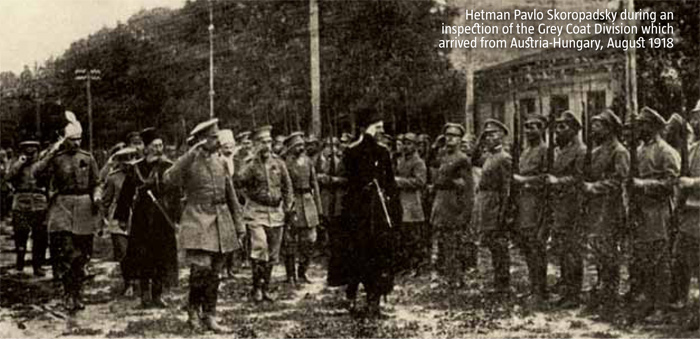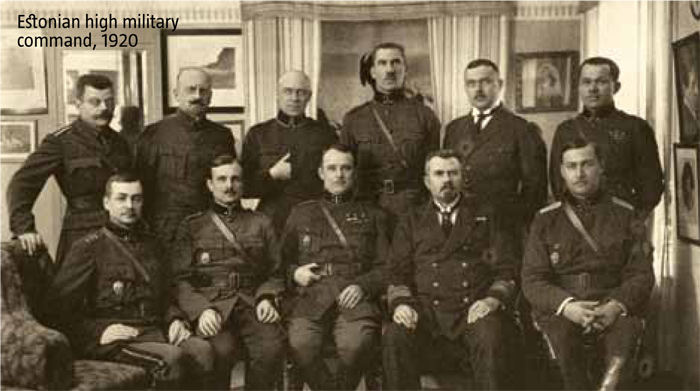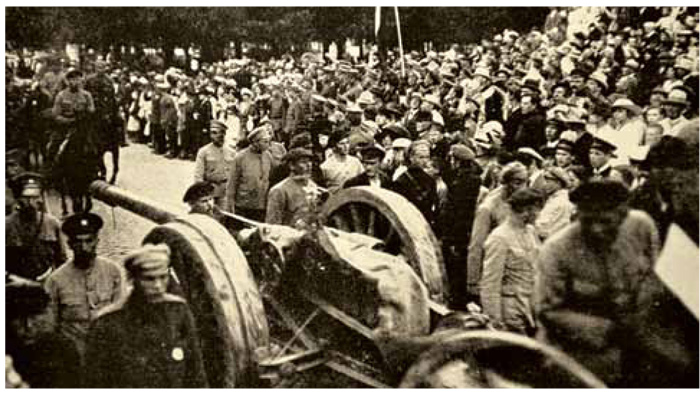Lenin once wrote that “only the revolution that is able to defend itself is worth anything”. Regardless of what you think of Lenin, these words are undeniably true. The experienced practicing revolutionary knew what he was saying. Unfortunately, the Ukrainian Revolution of 1917-21 was unable to defend itself. What caused its failure? Among all the negative factors and phenomena, a key role was played by the reckless, ruinous military policy of the then leaders of Ukraine.
SLOGANS INSTEAD OF WEAPONS
Advocates of independence had a dominant place in the Ukrainian military movement since its inception. However, the leaders of the Ukrainian Central Rada (UCR) and leaders of the most powerful Ukrainian parties (Social Democrats, Socialist Revolutionaries and Socialist Federalists) preferred autonomy for Ukraine and consequently did not pay sufficient attention to building Ukraine’s own armed forces. They viewed the Ukrainian military movement as a trump card in fighting against the central Russian authorities to achieve their moderate demands. This is the root of the antimilitarist line adopted by the socialist leaders of the UCR who essentially rejected the idea of a national army. Deputy Head of the Central Rada Volodymyr Vynnychenko wrote: “It is not our own army that we Social Democrats and all genuine democrats need but the destruction of all regular armies.”
These utopian views were reflected in the Fourth Universal which proclaimed the independence of the Ukrainian National Republic. “Disband the army altogether and later form a popular militia instead of a regular army so that a military force would serve to defend the working people rather than the desires of the ruling strata,” read the document authored, again, by Vynnychenko. These calls dealt a dangerous blow to the Ukrainian military movement. It was stripped of the very goal to which it aspired – building a regular national army.

Militias which UCR leaders advocated were not a poor format in and of themselves (for example, the contemporary Swiss army is formed on this principle), but the guarantee of their success is a patriotic population ready to come to the defence of its state. In this area, UCR leaders failed and exhibited immaturity and shortsightedness. They went with the flow, and were unable to handle the rapidly changing situations they encountered and did not direct popular masses but rather acted under their influence. But this kind of inertness, combined with polite words and a theatrical stance, brought certain dividends to UCR officials in their debate with the conservative Russian Provisional Government. The Russians believed the UCR because it had the sympathy of the Ukrainian population. But when power in Petrograd was seized by the Bolsheviks, the situation was completely changed, and because of their political naiveté and lack of resolution, the Ukrainian leaders lost the decisive battle for the minds of the soldiers.
The Bolshevik agitators used skilfully crafted propaganda built on populist slogans, rather than rifles and guns, to pull a large number of soldiers in Ukrainized units out from under the ideological influence of moderate Ukrainian parties. Wearied with battle fatigue, the soldiers wanted to go back home as soon as they could in order to divide up the landowners’ land. In this situation, according to Vynnychenko, UCR officials sadly watched “regiments named after various hetmans which so consciously, orderly and resolutely entered the capital of Ukraine to defend and protect it, which cheered up every Ukrainian heart with their national awareness, sincerity, blue-and-yellow flags and Ukrainian songs and which so loudly shouted ‘Glory!’ to the Ukrainian authorities. These regiments strangely lost their zeal after a few weeks, then fell into apathy, ‘neutrality’ to the Bolsheviks and then … turned, together with the Bolsheviks, their Ukrainian bayonets against us.”
READ ALSO: The Price of Egoism
The numbers of troops loyal to the UCR was rapidly falling. In late autumn 1917, the UCR had about 300,000 loyal soldiers on territories it controlled, while a mere 2,000 rose to defend Kyiv against a 30,000-strong Bolshevik force in January 1918. Most of these Ukrainian soldiers fought inside the city, squashing the insurgency at the Arsenal plant, while the last reserve – patriotic youth – was sent into battle to defend the eastern approaches to Kyiv.
Bolshevik troops had both a numerical and qualitative advantage. This was especially true in the way they organized the military, using money, terror and propaganda to reach their objectives. In fact, the Bolshevik party itself had the nature of a paramilitary organization with strict centralism and discipline. Moreover, the Ukrainian authorities lacked mobilization resources to replenish their army. Its main reserve, the peasants, had already been exhausted by the First World War, both physically and morally. The UCR failed to win over the industrial proletariat, which was relieved of military service during the war and was “fresh” in that regard. Russianized workers treated the Ukrainian cause with hostility and gladly teamed up with the Bolsheviks.
ENCHANTED WITH “REGULARITY”
The troops of the Ukrainian Central Rada failed to contain the enemy, but the Bolsheviks did not rule for very long, either. They were driven out by the Germans and Austrians who entered Ukraine after the Treaty of Brest-Litovsk. When it returned to Kyiv, the UCR did not have its former authority or support and was disbanded following a bloodless coup in late April 1918. General Pavlo Skoropadsky became the new leader of Ukraine and was elected hetman. He was a professional military man without any socialist illusions about militias, so he set about forming a regular army. First of all, he had to overcome the resistance of the Germans who told him: “Why do you need an army? We are here and will not permit anything bad to happen to your government inside the country. And you shouldn’t worry about your northern border: we will not let the Bolsheviks in. Form a small unit of 2,000 men to maintain order in Kyiv and for your personal protection.” Eventually Skoropadsky convinced the Germans, and they let him form eight army corps. The army grew to 60,000 men and was to reach 300,000 by spring 1919.

However, the new authorities made a mistake in their enchantment with a “regular” army. The people who were responsible for army formation thought in outdated terms and failed to grasp the special demands of revolutionary times. They took a methodical approach to forming the army, starting with administration. They saw their main task in developing the staff lists for various military units in the smallest detail and drawing up budgets for them. Such methods were completely out of touch with the realities of the time. As a result, they did not have enough time, money or energy to form an army.
READ ALSO: Europe in Communism's Crosshairs
Another problem faced by the builders of the hetman’s armed forces was a lack of social loyalty, among both civilians and the military. Almost the entire commanding staff consisted of officers of the former tsarist army. Most officers were not supportive of the Ukrainian cause and viewed it as a way to make it through tough times. At the same time, wide masses of the population did not have a developed sense of national identity and easily fell under the influence of socialist and communist propaganda. Slogans of land reform and nationalization of industry hit their marks.
The majority of the population did not support the hetman’s conservative regime which relied on German and Austrian invaders. Consequently, the opposition did not have much difficulty stirring up an insurgency in autumn 1918. And this meant the end of Skoropadsky's rule.
AVENGERS OF THE WRONGED PEOPLE
During the insurgency, a bigger part of the hetman’s army switched to the Directory of the UNR. Together with the units of insurgent otamans, the Directory’s troops had about 100,000 men after mobilization in Left-Bank Ukraine in early 1919. Born in the whirlwind of popular resistance, these armed forces proved to be neither battleworthy or organized. Anarchy was on the rise and discipline in decline. Various otamans pursued their own policies, failed to comply with the higher command and eventually had the upper hand. Professor Taras Hunchak aptly said that this army was “an avenger of a wronged people rather than a builder of a new life.”
In order to put it in place, the unanimous political will of the leaders and firm state power were needed. But these were, in fact, exactly the things that were lacking. The Ukrainian parties were splitting into competing factions; yesterday’s allies and like-minded political forces were turning into archenemies; governments replaced each other in a kaleidoscopic fashion; the state could not decide on either its domestic or foreign policy. Every politician viewed himself as the only saviour of Ukraine. They actively involved the army in their intrigues, which led to its further degradation. The army command was constantly restructuring military units, which contributed to their decline. Against the backdrop of political division and internal corruption within the army, the Bolsheviks captured Left-Bank Ukraine, approached Kyiv for the second time and took a larger part of Right-Bank Ukraine. The Poles were approaching Ukraine from the west, and the Entente troops had landed in the south. Ukraine found itself encircled by enemies and alone, without any allies.

Latvian troops in Riga, 1919
The situation improved in the summer of 1919. Power was concentrated in the hands of Symon Petliura, the head of the Directory. His political opponents became discouraged and, as Isak Mazepa put it, “lost their heads and left the battlefield”, i.e., went abroad. The rule of otamans in the army was ended. Several coups were put down, and order and discipline restored. Special inspectors with wide authority were introduced, similar to Bolshevik commissars. The army grew as 35,000 soldiers of central Ukraine were joined by 50,000 Galicians. Having this force, the army of the UNR launched a successful raid on Kyiv and Odesa in August 1919. It seemed that military fortune was again with Ukrainians. But instead of Bolsheviks they had a new enemy, General Denikin’s White Guard. Denikin did not recognize Ukraine's existence as a state as he strove to restore the “one and indivisible” Russian Empire. A new military conflict erupted, and Ukrainians were defeated – not by White Guard generals but by an epidemic of spotted fever which swept through the army. In this war, the UNR government lost the territories it controlled, while the surviving military units ended up in Volhynia and, being surrounded by the White Guard, Bolsheviks and Poles, switched to guerrilla warfare. The Ukrainian government essentially left the political stage as an independent player by the end of 1919.
READ ALSO: Life Without Illusions
Any further success required having a powerful ally. In April 1920, Ukraine found one in Poland by signing an agreement on joint actions against the Bolsheviks. However, despite promises, the Poles never allowed Ukrainians to build their own army, limiting it to 10,000-20,000 men. In October 1920, Warsaw signed a separate peace treaty with the Bolsheviks and refused to maintain its alliance with the Ukrainians, which enabled the UNR government to carry out a mobilization campaign in Podillia, increasing the army to 40,000 men. However, it was too late: the Ukrainian army suffered its final defeat at the hands of the Reds the following month. Its remaining parts were interned by the Poles. The military struggle of regular units was over.
BALTIC PRAGMATISM
Just like many other peoples in the former Russian empire, Ukrainians were unable to defend their independence. Only the Poles, Finns, Lithuanians, Latvians and Estonians formed their own states. The Baltic peoples found themselves almost in the same situation as the Ukrainians at the time, which is why their experience is of the highest instructional value. All of them were stateless peoples for a long time, and their interests were not taken into account during the First World War by the big powers. The rapid national renaissance in the Baltic region began only after tsarism was overthrown in Russia. Initially, their political leaders also favoured autonomy and were in no hurry to declare independence: Lithuanians did so on 16 February, Estonians on 24 February and Latvians on 18 November 1918. All three countries experienced German occupation and the arrival of the Reds who quickly turned off people with their terror. At the same time, the Baltic national leaders offered a clear programme for solving political and socioeconomic issues in a democratic way, without socialist utopia or radicalism. This had a positive effect on all areas of statehood building, including the military: universal military conscription was introduced and was followed by a successful mobilization campaign. One efficient stimulus was a decision by the Estonian government to grant plots of land, free of charge, to all heroes of the war for freedom, as well as to wounded soldiers and family members of the deceased. These measures very quickly bore fruit. In early January 1919, the Estonian army had fewer than 5,000 men, but its numbers grew to 23,000 by the end of the month and to 80,000 in May. The Latvian army grew to 76,000 men and the Lithuanian forces to 60,000 by the end of 1919. Around 5,000 Estonians, 4,500 Lithuanians and 3,000 Latvian soldiers were killed in action as they fought for the independence of their countries. These are significant numbers for such small nations.
READ ALSO: Divided Between Two Motherlands
An important factor of victory was foreign aid to the Baltic states. After the demise of the Russian Empire, Lithuania, Latvia and Estonia found themselves in the British sphere of influence. Britain directed its efforts not only at beating the Bolsheviks, but also at weakening Russia by splitting off “nation states” from it. (Ukraine found itself in the French sphere of influence, but France’s interest was the opposite, namely restoring the Russian Empire.) London helped the Baltic governments with arms, ammunition and loans to purchase military equipment. British warships supported the actions of the Estonian and Latvian armies and British instructors worked in their armies. One was Field Marshal Harold Alexander, who would later defeat the Germans in the Battle of El Alamein. Several thousand Finnish, Swedish and Danish volunteers came to help Estonia. Polish and German troops were temporary allies of the Baltic states. However, after their common enemy was defeated, Estonians and Latvians began to fight against the Germans, who wanted to create their own puppet state in the region, while a Polish-Lithuanian conflict erupted in October 1920. The political maturity and pragmatism of the Baltic leaders and the united and patriotic population enabled the three Baltic states to form battleworthy national armies, draw the attention of European powers to their struggle and receive significant aid from them. As a result, the Baltic republics defended their independence and achieved international recognition, while Ukraine lost its sovereignty and was occupied by foreign powers due to the shortsightedness of its politicians among a number of other factors.

